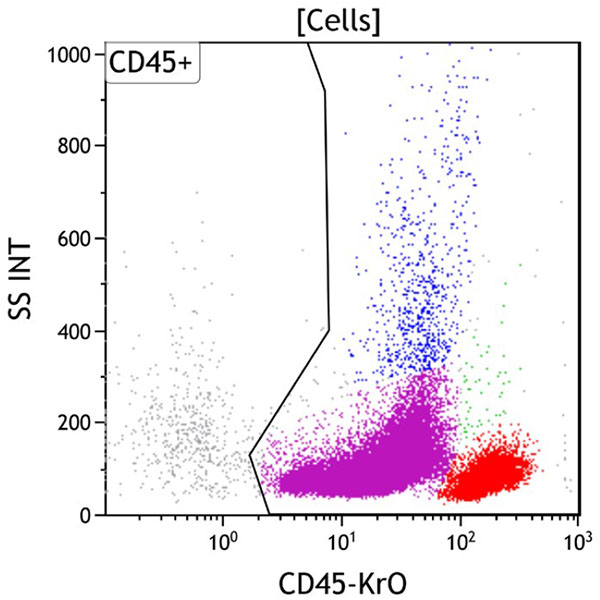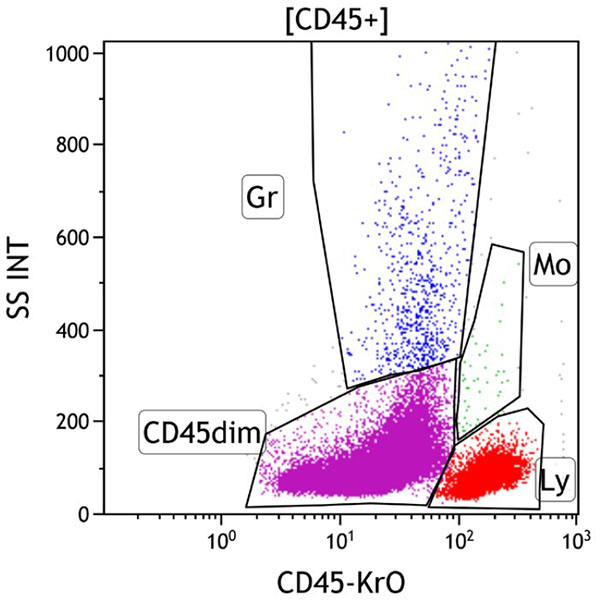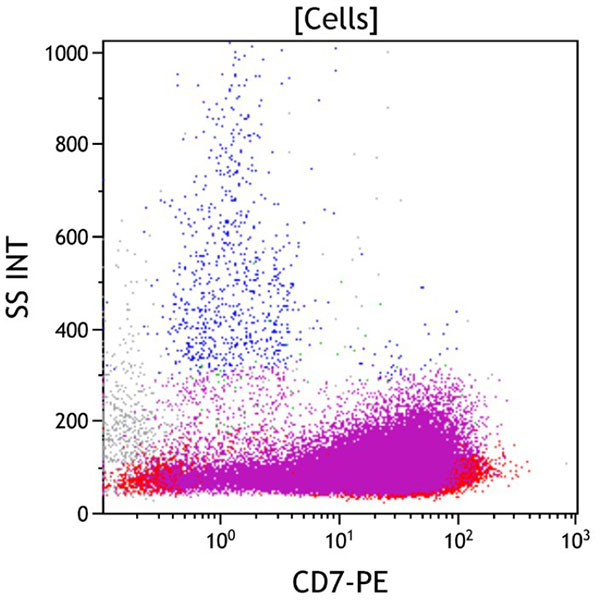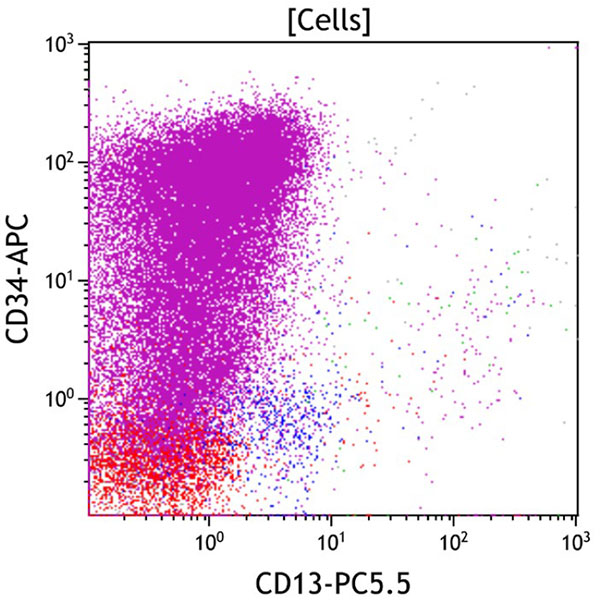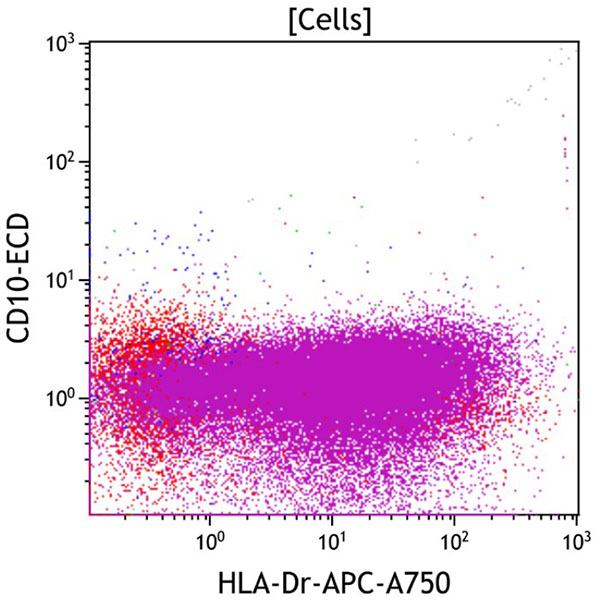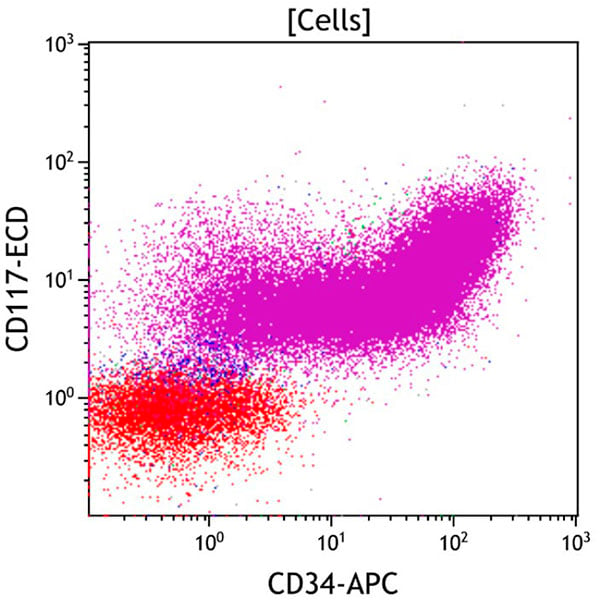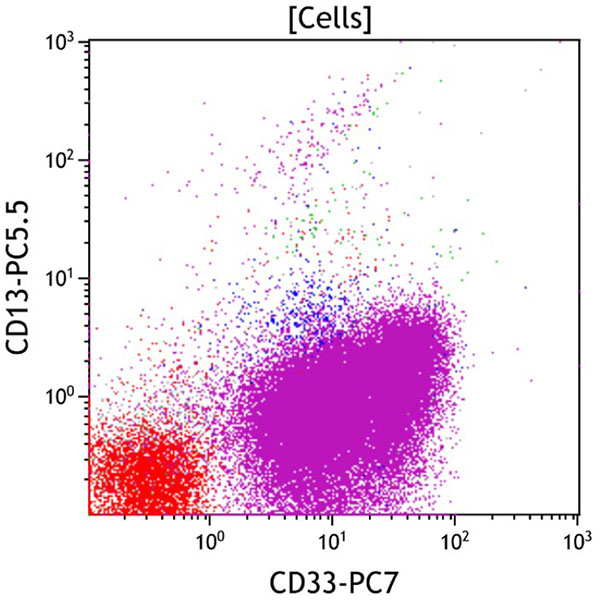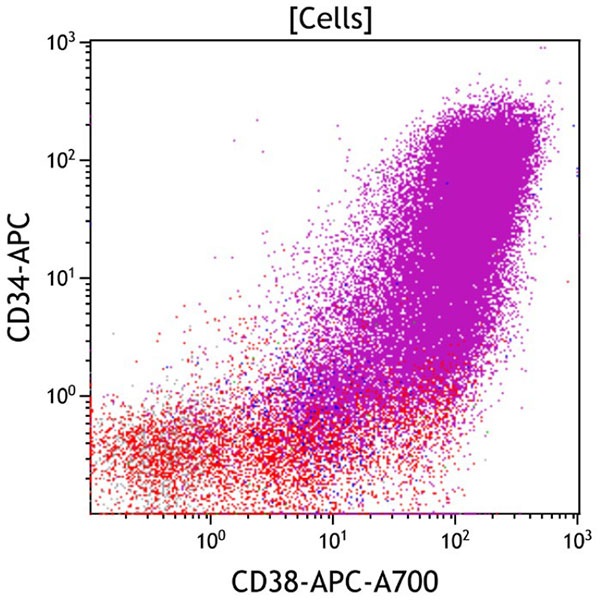Clinical Vignette
This 55-year-old male presents with circulating blasts on peripheral whole blood smear. A bone marrow aspirate sample is submitted for flow cytometric immunophenotyping using ClearLLab 10C Panels.
Flow Cytometric Immunophenotyping
M1 Cell Tube
Figure 1. This CD45 vs Side Scatter dot plot shows events in the Cells gate. This plot is intended to highlight various subsets of white blood cells, which are gated as CD45 positive. The CD45 negative population usually includes red blood cells, platelet aggregates, tissue debris or non-hematopoietic cells.
Figure 2. This CD45 vs Side Scatter dot plot shows events in the CD45+ gate. This dot plot permits distinction of several white cell populations typically found in peripheral blood, bone marrow, and lymph node samples, including lymphocytes (Gate Ly, red), monocytes (Gate Mo, green), and granulocytes (Gate Gr, blue). The CD45 dim gate (purple) covers the area typically occupied by myeloblasts and immature B cells. Basophils, plasmacytoid dendritic cells, plasma cells and NK cells may also fall in this area. By applying different colors to the events comprised by each gate, the various populations may be followed throughout the analysis. Note the expanded progenitors in the CD45 dim gate (purple).
Figure 3. This CD7 vs Side Scatter dot plot shows all viable cells. CD7 is expressed on immature T cells at the earliest stage of T cell development and persists throughout T cell maturation to be variably expressed on mature T cells (red). It is also uniformly expressed on NK cells (red), and dimly expressed on a subset of plasmacytoid dendritic cells and a subset of the lineage committed progenitors. The expanded progenitors (purple) express intermediate to bright CD7.
Figure 4. This CD13 vs CD34 dot plot shows all viable cells. CD13 is expressed on maturing granulocytes (blue), monocytes (green), basophils, and CD34 positive progenitors. CD34 is expressed on early hematopoietic progenitors. CD13 is not well expressed on CD34 positive B cell progenitors or mature lymphoid cells (red). The expanded progenitors express CD34 and dim to absent CD13.
Figure 5. This HLA-DR vs CD10 dot plot shows all viable cells. HLA-DR is expressed on monocytes, B cells, plasmacytoid dendritic cells, and CD34 positive progenitors CD10 is expressed by mature granulocytes and immature B cells. Immature B cells express both CD10 and HLA-DR. The expanded progenitors variably express HLA-DR but do not express CD10.
M2 Cell Tube
Figure 6. This CD34 vs CD117 dot plot shows all viable cells. CD34 is expressed on myeloid blasts and early immature B cell precursors. CD117 is expressed on myeloid blasts, promyelocytes (in blue), and early erythroid precursors, but negative on early B cell precursors. The expanded progenitors (purple) express intermediate CD34 and CD117.
Figure 7. This CD33 vs CD13 dot plot shows all viable cells. CD33 and CD13 are expressed on monocytes (green), maturing granulocytes (blue), basophils, and CD34 positive progenitors. Monocytes express CD33 at a uniformly high level with more variable CD13. Immature granulocytes express higher CD33 and lower CD13 than more mature granulocytes. Lymphocytes largely do not express either CD13 or CD33 (red). The expanded progenitors (purple) express intermediate to bright CD33 and dim to absent CD13.
Figure 8. This CD38 vs CD34 dot plot shows all viable cells. CD38 is uniformly expressed on lineage committed early progenitors having variable CD34. The expanded progenitors (purple) have coexpression of CD34 and CD38.
To view all flow cytometric dot plots, download the case in PDF format below
Results of Flow Cytometric Immunophenotyping
Flow cytometric immunophenotyping identifies a phenotypically distinct population of blasts with expression of intermediate CD7, dim to absent CD13, intermediate CD33, intermediate CD34, intermediate CD38, dim CD45, intermediate CD117, intermediate CD123 and variable HLA-DR without CD14, CD15, CD64 and other lymphoid or myeloid antigens. Compared with normal CD34-positive progenitors, the near-uniform expression of CD7 and decreased expression of CD13 is aberrant.
The immunophenotype of the abnormal population is that of expanded abnormal CD34-positive progenitors. This finding is consistent with an acute leukemia with myeloid differentiation (based on CD33 and CD117 expression). However, additional testing for cytoplasmic CD3 and cytoplasmic myeloperoxidase is indicated to exclude early precursor T-lymphoblastic leukemia and mixed phenotype acute leukemia. Correlation with clinical, morphologic and cytogenetic findings is required for definitive classification.

